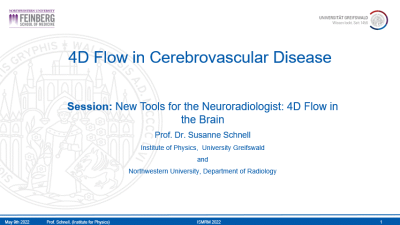Sunrise Course
New Tools for the Neuroradiologist: 4D Flow in the Brain
Joint Annual Meeting ISMRM-ESMRMB & ISMRT 31st Annual Meeting • 07-12 May 2022 • London, UK

| 08:00 |  |
4D Flow in Cerebrovascular Disease: How Do We Do It?
Susanne Schnell
4D flow MRI is a phase-contrast MRI method that is time-resolved, acquired in 3D, and uses 3-directional velocity encoding to fully resolve the 3-dimensional velocity vector. Data analysis involves the correction of noise and errors, vessel segmentation, and data visualization. Applications in cerebrovascular disease include aneurysms, atherosclerotic disease, arterial-venous malformation (AVM), as well as Alzheimer's disease. Hemodynamic parameters such as flow rate, peak velocity, relative pressure, or pulsatility can be calculated from the 4D flow MRI raw data to assess e.g. the severity of stenosis or blood flow redistribution after embolization of an AVM.
|
|
| 08:30 | 4D Flow in Cerebrovascular Disease: Why Do We Do It?
Jeremy Collins
4D Flow MRI is a volumetric flow technique extending the 2D flow paradigm into both space and time. This method has demonstrated utility in arteriovenous malformations, intracranial atherosclerosis, intracranial venous disease, assessing abnormalities in CSF flow, and identifying high risk flow features in intracranial aneurysms. Additionally 4D flow MRI has identified new insights into potential sources of embolic stroke.
|
The International Society for Magnetic Resonance in Medicine is accredited by the Accreditation Council for Continuing Medical Education to provide continuing medical education for physicians.